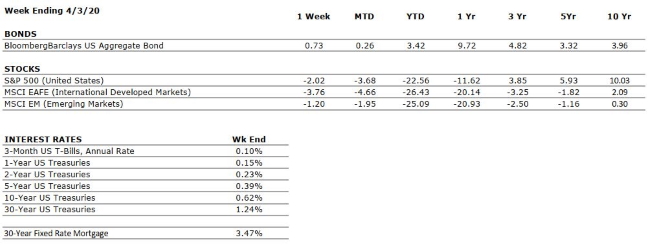by Connor Darrell CFA, Assistant Vice President – Head of Investment
Last week brought another series of large swings in equity markets as investors had to balance the still uncertain (though expectedly profound) impacts of government quarantining efforts relating to COVID-19 with historically strong economic policy responses. Markets managed to push meaningfully off of their lows, largely buoyed by optimism surrounding economic policy support. On Monday, the Federal Reserve announced that it would uncap the amount of capital it could pump into financial markets and established other means of providing liquidity to the system. This aggressive action was followed just days later with the passage of a $2.2 trillion fiscal response (known as the CARES Act) aimed at providing aid to troubled workers and businesses. Also hidden in the week’s news flow was a massive increase in claims for unemployment benefits, which skyrocketed to 3.3 million, smashing the previous record of 695,000. Additional data revealed that euro zone and Japanese manufacturing was in the midst of a sharp contraction. We expect the economic data to continue to worsen before getting better but remind investors that much of the negative data likely to come is already expected by markets, which are forward-looking by nature.
Behavioral Finance: A Primer
Much
of our previous communication has been focused on providing our interpretation
of the data related to the pandemic, as well as frequent reminders of the
importance of discipline. But for many investors who are facing an
unprecedented amount of volatility in markets, remaining disciplined is much
easier said than done. As human beings,
our brains are wired to address risks and evaluate decisions in certain ways,
and in many instances, the mechanics of our cognitive functions can lead us to
make investment decisions that may prove to be contrary to our best financial
interests.
Interestingly, there is an entire field of
finance that is devoted to studying the psychology of investing. Advancements
in our understanding of the human decision-making process
have provided practitioners of “Behavioral Finance” with lots to offer in terms
of understanding the behavior of investors. In our view, one of the most
important benefits of understanding behavioral finance is that we can use our
understanding of our own psychology to help improve our investment decision
making. Below, we provide a summary of some of the most significant
psychological pitfalls and how they may negatively impact us over the
long-term:
1. Loss Aversion
All investors hate losing money, but the
concept of loss aversion goes beyond this simple notion and suggests that human
beings’ aversion to paper losses can greatly impact investment decisions.
Specifically, study after study has shown that the “pain” associated with
losing money on an investment is more powerful than the “pleasure” derived from
earning it. In the midst of a volatile market, this can cause us to feel the
urge to take action in an effort to protect ourselves from realizing further
losses, even if such action would not be in concert with our long-term
investment objectives. In order to combat this desire, it is essential for us
to focus on our goals and objectives in an effort to focus on the things we
have direct control of over time. This might include
making temporary adjustments to our savings and consumption rates or taking
advantage of cost-saving
opportunities such as lower interest rates, rather than making drastic
adjustments to our portfolios.
2. Confirmation Bias
Another flaw in the way we digest
information is confirmation bias. Confirmation bias occurs when we
inadvertently place higher emphasis on data or information that supports what
we already believe, rather than taking it into consideration at face value. For
example, if we believe strongly in the resiliency of the U.S. economy, we may
overemphasize positive information about U.S. stocks and discount whatever negative views we may
encounter that do not support
this belief. For many of us, this bias
may lead to us rushing to sell positions that have underperformed on a relative
basis and flock to those that have performed better. Giving in to these types
of biases can cause us to sacrifice proper diversification in our portfolios at
the precise time that diversification takes on heightened importance.
3. Herding
Herding is the behavior that leads to our
desire to “follow the crowd.” This is often driven by fear of regret or of
“missing out” (also known as FOMO). Throughout history, there are a plethora of
examples of points in time where market sentiment reached levels that were far
too extreme (this includes periods that fall in both bull and bear markets). In
these instances, those who were able to refrain from following the popular
decision (whether that be to buy more when stocks were expensive, or to sell
when markets were in peril) have often come out ahead. Given the volatility we
are experiencing now, it is important for us to take a step back and develop
our own conclusions rather than simply following the trend.
4. Illusion of Control
Illusion of control bias is a bias in
which people tend to believe that they can control or influence outcomes when,
in fact, they cannot. One example of this bias in a practical study occurred
when a social experiment conducted in the 1980’s found that people permitted to
select their own numbers in a hypothetical lottery game were willing to pay a
higher price per ticket than subjects gambling on randomly assigned numbers.
The belief that we have more control than we really do on the outcome of our
investment returns can lead us to take inappropriate action within our
portfolios. To combat this, it is important to think of investing as a
probabilistic activity, and that the probability of different outcomes is
beyond our control. During periods of market stress, it can be easy to lose sight
of the fact that long-term returns are driven largely by circumstances beyond
our control, and that the probability of experiencing positive returns
increases with an investor’s time horizon.
5. Representativeness
Representativeness is a type of selective memory
that causes us to place too much weight on recent evidence rather than taking a
more holistic approach to decision making. This can cause investors to focus
too much on short-term performance without considering the evidence that may be
found in the more distant past. With markets having fallen so quickly from
their highs, there are likely to be many high-quality
stocks out there which still have very promising long-term prospects but may have fallen considerably off of their
previous prices. If we become too concentrated on the recent past, or even on
the fact that these businesses may operate in industries that could be
particularly troubled in the current environment (i.e., energy or
consumer discretionary), we may be more likely to lose sight of the business’
strengths.
All of the above
biases are particularly important to consider in the current investing climate,
because they can lead us to make suboptimal decisions during a time of stress.
Behavioral economists have found that we can help to reduce the negative
impacts that our cognitive biases may have on our decision-making process just by simply acknowledging that
they exist. This can help us to remain more objective and less emotional when
considering what (if anything) should be done to adjust our portfolios in this
time of uncertainty.




